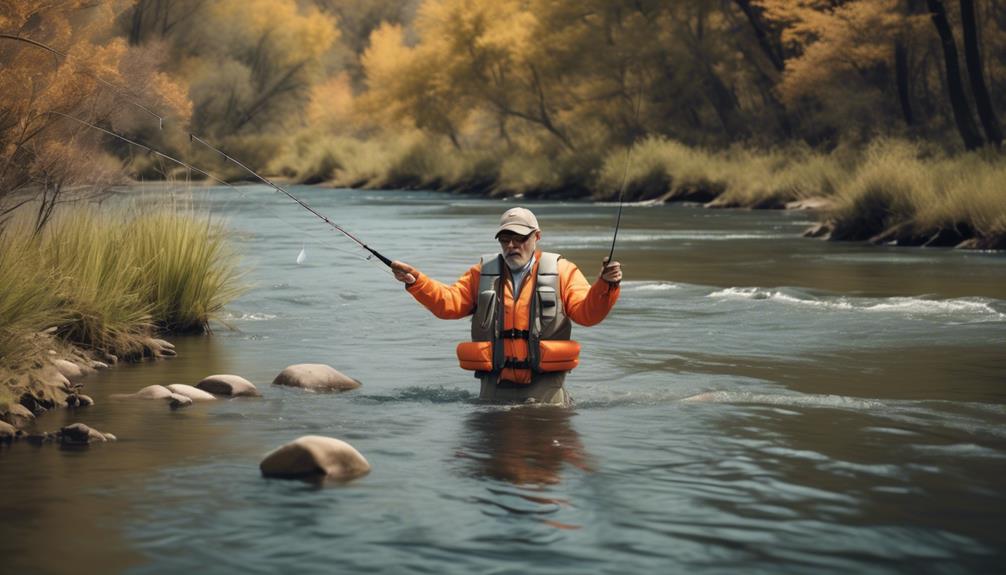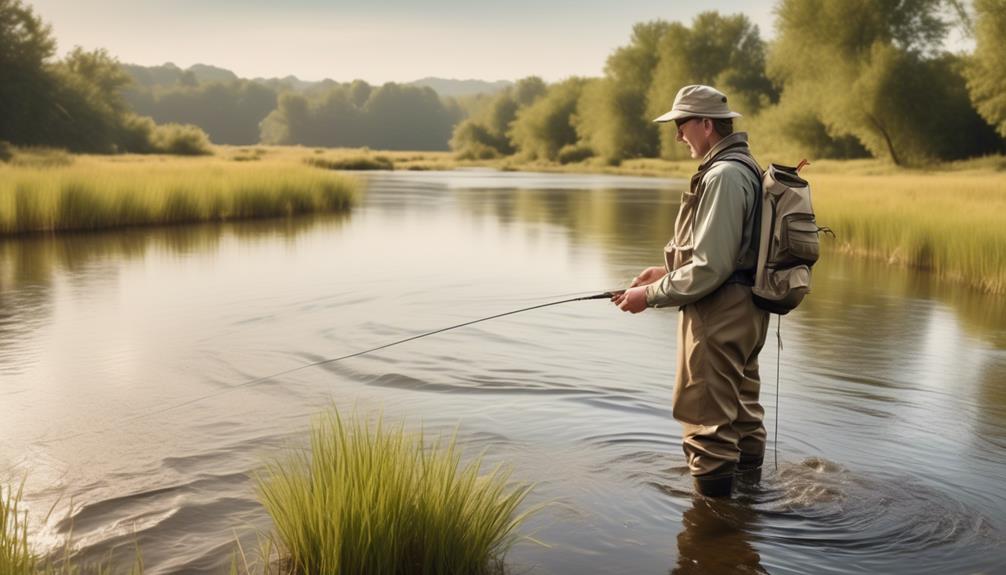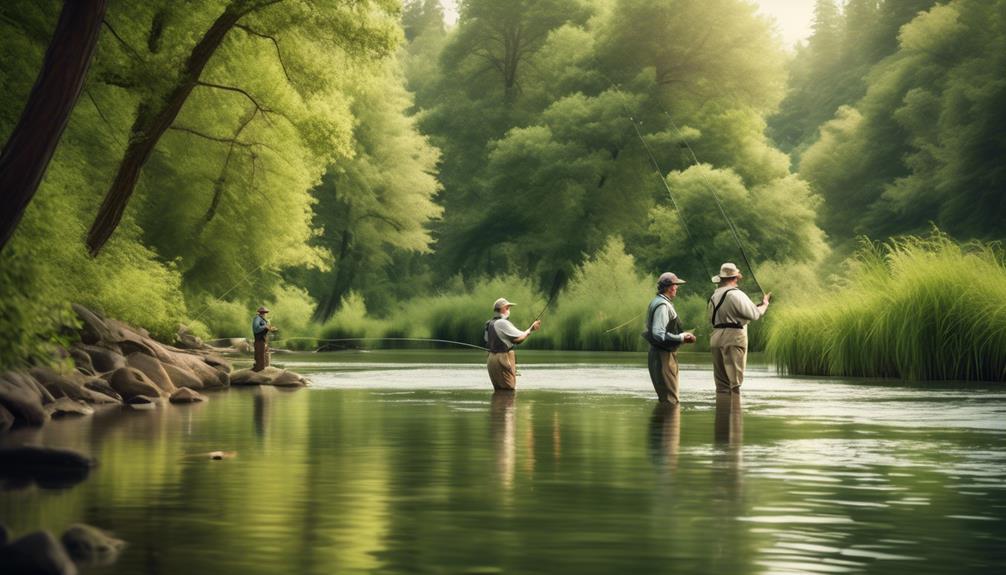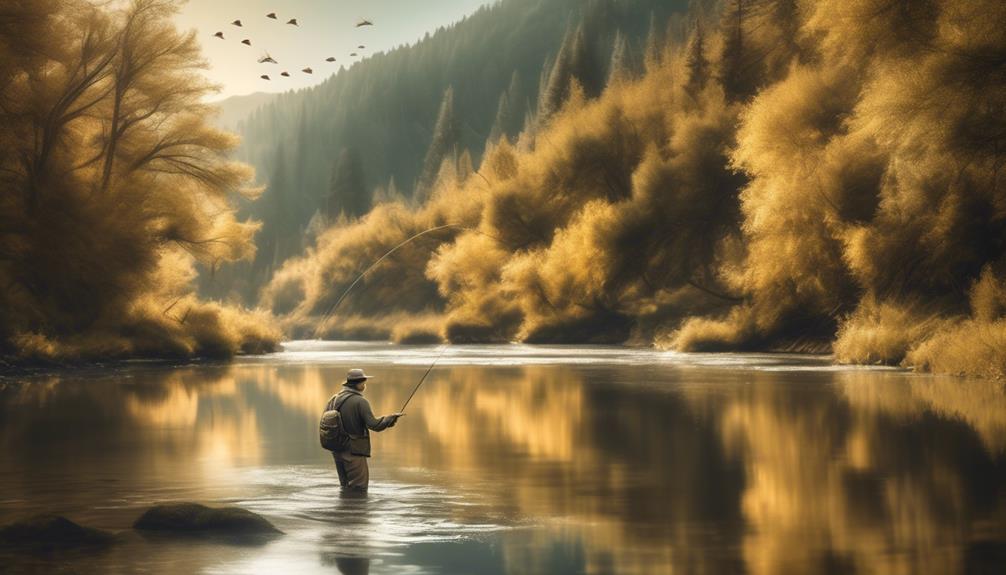Coincidentally, you find yourself drawn to the serene beauty of rivers and the tranquility of nature. As you stand by the water's edge, watching the gentle ripples and the occasional rise of a fish, the idea of taking up fly fishing begins to take hold.
But where do you start? How do you begin this journey into the world of fly fishing, a sport that seems to blend art, science, and nature in such a unique way?
Well, there are a few essential things you need to know to get started on your fly fishing journey, and by the end of this guide, you'll have a solid foundation to build upon.
Gear and Equipment
Before heading out to the water, ensure you have the right gear and equipment for a successful fly fishing experience. Choosing the right gear is crucial. Finding quality equipment will greatly impact your overall enjoyment and success.
First, understanding different types of flies is essential. Flies are designed to imitate various insects and small creatures that fish feed on. You'll need to select flies that match the insects present in the area where you'll be fishing. This will increase your chances of enticing the fish to bite. Your local fly shop or online resources can help you identify the most effective flies for your chosen fishing location.
Next, selecting the right lines is equally important. Fly fishing lines come in various weights and tapers, each designed for specific fishing conditions and types of fish. Heavier lines are suitable for larger fish and windy conditions, while lighter lines are ideal for smaller fish and delicate presentations. Consider the type of water you'll be fishing in, as well as the size and species of fish you're targeting when choosing your line.
Investing in the right gear and equipment will significantly enhance your fly fishing experience. Take the time to research and seek advice from seasoned fly anglers to ensure you have the appropriate gear for your specific fishing needs. With the right gear and equipment, you'll be well-prepared to embark on a successful and enjoyable fly fishing journey.
Selecting the Right Rod
To ensure an optimal fly fishing experience, selecting the right rod is crucial for effectively casting and controlling your line. When it comes to choosing the right rod, two key factors to consider are rod weight and material composition.
Rod weight is an important consideration as it determines the size of flies and the type of fishing you'll be doing. Heavier rods are suitable for larger fish and in windy conditions, while lighter rods are ideal for smaller fish and delicate presentations. Common rod weights range from 1 (the lightest) to 12 (the heaviest), with mid-weight rods around 4 to 6 being versatile for beginners.
Material composition is another essential aspect to think about when selecting a fly fishing rod. Most fly rods are made from graphite, fiberglass, or bamboo. Graphite rods are popular due to their lightweight and stiff characteristics, making them a good choice for beginners. Fiberglass rods are more flexible and forgiving, making them suitable for short casts and small streams. Bamboo rods are the traditional choice, known for their slow action and classic feel, but they require more maintenance.
Understanding Flies and Lines
When selecting the right rod for your fly fishing journey, understanding the different types of flies and lines is essential for effectively targeting and presenting your offerings to the fish. Choosing flies that match the insects present in the water and the fish's feeding habits is crucial for a successful fly fishing experience.
There are various types of flies, including dry flies, nymphs, streamers, and terrestrials, each designed to imitate different stages of aquatic or terrestrial insects. Matching lines to the flies you're using is also important. For instance, a floating line is suitable for dry flies and topwater presentations, while a sinking line is better for getting streamers down to where the fish are.
Here are some key points to consider:
- Fly Selection: Understand the local insect hatches and the fish species you're targeting to choose the right flies. Different types of flies imitate different insects and baitfish, so understanding the local ecosystem is essential.
- Line Matching: Match the weight and type of your fly line to the type of flies you plan to use. This ensures that you can effectively cast and present your flies to the fish in a natural and enticing manner.
- Presentation: Consider how you want your fly to behave in the water and choose the appropriate line and casting technique to achieve that presentation. Different lines and casting methods can affect how the fly moves and behaves in the water, influencing its attractiveness to the fish.
Learning Basic Casting Techniques
Mastering basic casting techniques is essential for becoming proficient in fly fishing. Improving accuracy and refining timing are crucial aspects of casting that will greatly enhance your overall fly fishing experience.
To improve accuracy, focus on your casting stroke and aim to be precise in your movements. Start by practicing the basic overhead cast, which is the foundation for many other casting techniques. Keep your wrist firm and concentrate on a smooth acceleration followed by an abrupt stop. This will allow the line to roll out in front of you with precision.
As you progress, you can experiment with different casting techniques such as the roll cast or the sidearm cast to adapt to various fishing environments.
In addition to accuracy, refining your timing is essential for successful casting. Timing is all about when to apply power to the casting stroke and when to pause. It's crucial to coordinate the movement of the rod and the line to achieve a smooth and efficient cast. Practice regularly to develop a sense of timing and rhythm, which will help you cast with ease and grace.
Identifying Fishing Spots
Improving your casting techniques will help you identify prime fishing spots along the river or stream where fish are likely to gather. As you advance in your fly fishing journey, spot selection becomes crucial for a successful day on the water.
Here are some tips to help you identify the best fishing spots:
- River Knowledge: Understanding the river or stream you're fishing in is essential. Look for areas where the current slows down, such as behind large rocks, along the banks, or near submerged logs. These are prime spots where fish often gather to rest and feed. Additionally, knowing the depth of the river at different points can also help you identify potential fishing spots.
- Fly Fishing: When scouting for fishing spots, consider the type of fly fishing you're doing. For example, if you're nymph fishing, look for shallow riffles and runs. If you're dry fly fishing, focus on slower-moving water where rising fish are more likely to be found.
- Location Scouting: Take the time to walk along the riverbank and observe the water. Look for signs of fish, such as rising or feeding activity. Keep an eye out for aquatic insects, as they can indicate areas where fish are actively feeding.
Understanding Fish Behavior
To understand fish behavior while fly fishing, observe their movements and feeding patterns to anticipate their actions in different water conditions. Fish feeding habits vary depending on the species and the environment. By understanding when and where fish feed, you can increase your chances of a successful catch.
For example, trout are known to feed actively in the morning and evening, while bass tend to hunt for prey in shallow waters during warmer seasons. Observing the type of insects or other organisms present in the water can also give you valuable clues about what the fish are feeding on.
Fish migration is another important aspect of their behavior to consider. Many fish species migrate to different locations for breeding, feeding, or seeking suitable water conditions. Understanding the patterns of fish migration can help you predict where to find them.
For instance, during the spawning season, certain fish species migrate upstream in rivers and streams. By knowing these patterns, you can plan your fly fishing trips accordingly and target the areas where fish are likely to be present.
Fishing Etiquette and Safety

Observing fish behavior and understanding their movements will also guide your actions for practicing proper fishing etiquette and ensuring safety while on the water.
When it comes to river etiquette, safety is paramount. Here are a few essential tips to keep in mind:
- Respect Other Anglers: Always give fellow anglers plenty of space, and avoid casting over someone else's fishing spot. Be mindful of their presence and try not to disrupt their fishing experience.
- Handle Fish with Care: Proper stream etiquette, safety, involves treating the fish with respect. Use barbless hooks to minimize harm, and wet your hands before handling the fish to protect their delicate protective coating.
- Be Mindful of the Environment: Leave no trace of your presence. Dispose of any trash responsibly, and be cautious not to damage the riverbanks or disturb wildlife. Remember that you're a guest in the fish's natural habitat.
In addition to proper river etiquette, it's crucial to prioritize safety. Always wear a personal flotation device when wading in rivers, and be aware of your surroundings to avoid potential hazards. Pay attention to the weather forecast and be prepared for any changes in conditions.
Joining a Fly Fishing Community
Consider reaching out to local fly fishing clubs or online communities to connect with fellow anglers and enthusiasts who share your passion for the sport. Joining a fly fishing community can provide you with valuable opportunities to learn from experienced anglers, share tips, and build lasting friendships with like-minded individuals. These communities often organize fishing trips, fly tying workshops, and educational events on stream ecology, offering you the chance to enhance your skills and knowledge.
Fly tying is an essential skill for any fly angler, and being part of a fly fishing community can give you access to workshops and demonstrations where you can learn the art of creating your own flies. By connecting with seasoned fly tyers, you can gain insights into different patterns, materials, and techniques, allowing you to customize your flies based on the specific conditions of the waters you fish.
Furthermore, understanding stream ecology is crucial for effective fly fishing. Joining a community can connect you with experts who can educate you on the intricacies of stream ecosystems, insect hatches, and how to effectively read the water. This knowledge won't only improve your angling skills but also deepen your appreciation for the natural environment.
In addition to skill-building opportunities, fly fishing communities provide a supportive environment where you can share your experiences, seek advice, and celebrate your fishing successes. Whether in person or online, being part of a community can enrich your fly fishing journey and make it even more rewarding.
Frequently Asked Questions
What Are Some Common Mistakes Beginners Make When Starting Their Fly Fishing Journey?
When starting your fly fishing journey, common mistakes include improper casting and lack of patience. It's essential to use proper equipment and take your time to learn the techniques for a successful and enjoyable experience.
How Can I Best Prepare for My First Fly Fishing Trip?
Before your first fly fishing trip, gather essential gear like a fly rod, reel, and waders. Practice proper casting techniques to improve your skills. Research local conditions and regulations to ensure a successful and enjoyable experience.
What Are Some Important Factors to Consider When Choosing the Right Fishing Spot?
When choosing a fishing spot, consider water conditions and fish species as crucial factors. Also, prioritize accessibility and safety to ensure a successful and enjoyable fishing experience. These elements will help you find the perfect spot.
How Do I Know if I'm Using the Right Fly for the Conditions?
You know you're using the right fly for the conditions by considering weather, water type, and observing the behavior of the fish. Adjust your fly selection and casting technique accordingly to match the environment.
What Are Some Tips for Handling and Releasing Fish in a Responsible and Ethical Manner?
When handling fish, always use wet hands to avoid damaging their protective slime. Keep them in the water as much as possible, supporting their weight until they swim away on their own. Practice ethical release practices for their well-being.
Conclusion
Congratulations on taking the first step towards becoming a fly fishing enthusiast!
With the right gear, knowledge of casting techniques, and understanding of fish behavior, you're well on your way to enjoying this rewarding and peaceful hobby.
Remember to always prioritize safety and respect fishing etiquette, and don't hesitate to join a fly fishing community to learn from experienced anglers and fellow beginners.
Happy fishing!



